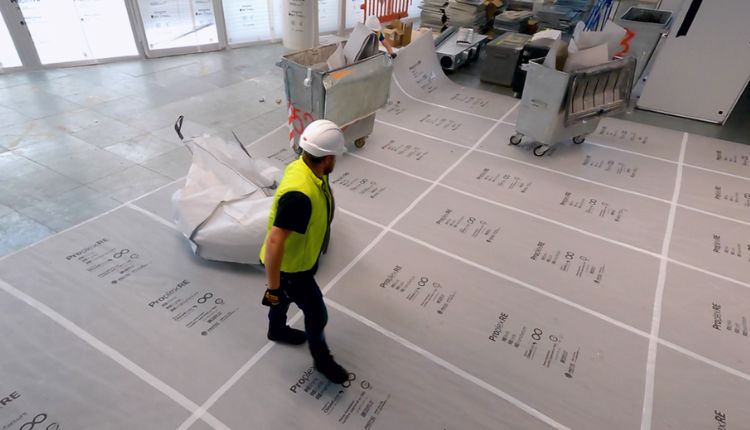In the rush to meet deadlines, manage labor, and juggle materials, many construction teams prioritize structural progress over site preservation. What often gets overlooked? Surface protection—especially when it comes to floors. On many job sites, floors aren’t protected until it’s too late, resulting in scratches, stains, dents, or full replacements that blow budgets and create friction between contractors and clients.
This raises a critical question: Are construction projects losing unnecessary time and money simply because floor protection isn’t treated as a strategic necessity from day one?
The Hidden Costs of Floor Damage
When floors are damaged during construction or renovation, the consequences ripple through the project timeline and budget. Damaged materials often lead to:
✅ Replacement costs (materials + labor)
✅ Project delays due to repair or reinstallation
✅ Costly insurance claims or disputes
✅ Deductions from the contractor’s payout
✅ Lower client satisfaction and negative reviews
In some cases, especially with premium flooring like hardwood, marble, or custom tile, replacement costs can run into thousands of dollars. When this happens after most of the project is completed, it becomes a stressful setback for both the contractor and the client.
Reputation Risk: More Damaging Than the Floor Itself
In today’s digital-first world, client reviews and referrals heavily influence contracting opportunities. Something as preventable as a surface scratch can easily escalate into a negative review about “lack of care” or “sloppy worksite handling.”
Clients tend to associate surface damage with a lack of professionalism or attention to detail—regardless of how well the construction work was completed. Over time, repeated complaints on such avoidable issues can impact a contractor’s ability to secure future bids.
Why Surface Protection Is Often Ignored
If floor damage is expensive and reputation-damaging, why do so many teams still overlook it? Common reasons include:
❌ Misjudging risk—assuming flooring is durable enough
❌ Waiting until finishing stages to protect surfaces
❌ Budgeting issues—seeing protection as an optional cost
❌ Underestimating job site foot traffic and tool movement
❌ Poor communication between teams on when floors are exposed
This mindset turns protection from a proactive strategy into a reaction-based cleanup effort—almost always at a higher financial and logistical cost.
A Shift in Perspective: Protection as an Investment, Not an Expense
Forward-thinking contractors now view surface protection as a cost-saving investment rather than an added burden. For a relatively small initial cost, using durable protective coverings can prevent thousands of dollars in damage and avoid project downtime.
Modern solutions are designed to withstand heavy foot traffic, tool drops, spills, and wheel movement from carts or lifts. Products like protective floor covering during construction help ensure that flooring remains untouched even in demanding job site conditions.
These coverings are engineered to be easy to install, reusable in some cases, and compatible with various types of flooring, making them a smart choice from both financial and practical perspectives.
Insurance and Liability: The Risk Factor Contractors Forget
Damage to installed flooring can also become a liability issue. In cases where the client claims negligence, contractors may face disputes or insurance complications. Insurers increasingly look at whether job site protections were implemented properly before approving claims.
By demonstrating protective measures upfront, contractors not only minimize damage risks but also strengthen their defense in potential liability scenarios.
Sustainability and Material Waste Reduction
Damaged flooring doesn’t just cost money—it contributes to material waste. Replacing ruined boards, tiles, or carpet sections increases landfill contributions and contradicts growing sustainability expectations in the construction industry.
More clients—especially in commercial and institutional projects—now expect construction teams to adopt waste-reducing practices, which includes preserving installed materials as part of an environmentally responsible workflow.
Time Saved Is Profit Gained
Replacing or repairing damaged surfaces extends the timeline, disrupts subcontractor schedules, and may cause cascading delays in finishing stages. Each day a project is delayed can impact profits, especially if there are penalties tied to late completion.
By protecting surfaces from the start, construction teams can stay on track with finishing deadlines—ensuring faster project turnover and better cash flow.
Prevention Beats Correction—Every Time
Surface protection isn’t a decorative afterthought—it’s a financial safeguard, a liability shield, and a reputation builder. Construction teams that continue to overlook it risk higher repair costs, strained client relationships, and delayed timelines.
By treating floor and surface protection as a non-negotiable part of project planning, contractors not only protect physical materials—but also protect their bottom line and brand integrity.
Because in construction, it’s not just about what you build—it’s about what you don’t destroy along the way.






